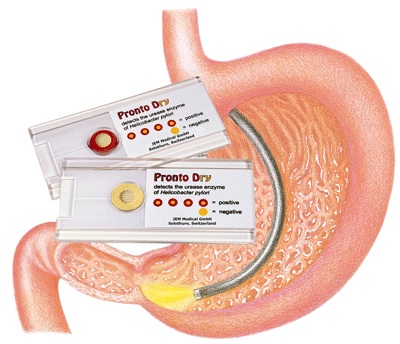Pronto Dry
Order Now!
Plus $14.95 shipping and handling charge per order.
or call 888 410-6566 to order
FREE samples available!
We use urease-impregnated filter dots as positive controls for Pronto Dry.
It is recommended that the control dot be used on negative tests where necessary.
Introduction
Since the discovery of Helicobacter pylori (Hp) by Marshall and Warren in 1983 (1), overwhelming evidence has accumulated to confirm that Hp infection plays a significant role in the development of chronic active gastritis, peptic ulcer, and gastric adenocarcinoma (2-6). Hp infection is very common throughout the world, occurring in 40-50% of the population in developed countries and 80-90% of the population in developing regions (7), and about 54.4% of the people in Taiwan (8).

A large number of methods, most of which require gastric biopsies, have been used to diagnose Hp infection, but there is no single gold standard test for the diagnosis of Hp infection (9-11). Every method for detection of Hp has its own inherent advantages and disadvantages. Although biopsy based tests may suffer from sampling error (12) due to the patchy nature of the infection, rapid urease test (RUT), with its high sensitivity and specificity, is considered to be a quick and reliable test for the initial diagnosis of Hp infection. Also, RUT is simple and inexpensive (13-16). When a biopsy is incubated in a medium containing urea and a pH-sensitive color marker, urease hydrolyses urea to carbon dioxide
Hepato-Gastroenterology 2002; 49:1191-1194 and ammonia, causing a rise in pH value and a change in the color of the medium.
In the past, the reaction time of most RUTs required 30 minutes on average, may have needed more than 4 hours in some cases (17,18). Patients must know the RUT results before their next visit to the OPD. If the reaction time can be reduced to less than 10 minutes, it allows a diagnosis to be made before the patient leaves the endoscopy suite. This may save on medical expenses due to repeated visits to the clinic and reduce paper work. It may also increase the success rate of eradicating Hp, because compliance is considered a major factor in the successful treatment of Hp, compliance may improve significantly if we make an early diagnosis of Hp infection and initiate therapy (19).
The present prospective study was undertaken to evaluate the validity of RUTs containing different media. This evaluation included accuracy, reaction time and cost-effectiveness. We also wanted to evaluate the positive reaction of different RUTs in relation to various colonies of Hp, and the accuracy of different RUTs in patients who had received prior Hp eradication therapy.
Abstract
Background/ Aims
The influence of different media on the validity of the rapid urease test, including accuracy, reaction time and cost-effectiveness is evaluated.
Methodology
Biopsies were obtained from the antral and body mucosa of 100 KMUH patients (51 men, 49 women; mean age: 54.0 years, range: 21-79 years old) undergoing gastroendoscopy due to dyspepsia. None of the patients had received any Helicobacter pylori eradicating treatment, nor any other antibiotic or bismuth treatment in the previous one month, nor had they had any type of gastric operation in the past.
Helicobacter pylori status was evaluated by seven different tests: culture, histology, home-made rapid urease test, 13C-urea breath test, and three different commercially available rapid urease tests - including the CLOtest, the Pronto Dry test, and the Pyloriset Urease test. Helicobacter pylori status was denned as positive when the culture was positive or if concordance of two of the other three tests (histology, homemade rapid urease test and 13C-urea breath test) was positive.
Results
Three different rapid urease tests have similar sensitivities (97.3% us. 100% vs. 100%) and specificities (98.4% us. 96.8% us. 98.2%), and accuracy (98.4% us. 96.8% us. 98.2%). But the reaction time was longer in the CLOtest than for the other two rapid urease tests (22.3 us. 5.6 us. 10.1 minutes) (P<0.05). The Pronto Dry test and the Pyloriset Urease test also have more rapid positive rate than CLOtest. However, in vitro study, three tests show similar rapidity of positive reaction at different densities of Helicobacter pylori.

Conclusions
These three tests have practical advantages for physicians who need a rapid and accurate method of diagnosing Helicobacter pylori infections. The Pronto Dry test and Pyloriset Urease test have degrees of accuracy similar to the CLOtest, but results are obtained more rapidly and they are cheaper. Furthermore, the Pronto Dry test can be stored at room temperature and thereby save on the storage expense.

Order Now!
Plus $14.95 shipping and handling charge per order.
or call 888 410-6566 to order
FREE samples available!
We use urease-impregnated filter dots as positive controls for Pronto Dry.
It is recommended that the control dot be used on negative tests where necessary.
Pronto Dry Story

Prof. Stanislaw Kafel, Warsaw, Poland

Dr. Carolyn Matherly
In the 1980's, a professor in Poland, at a time when Poland was still communist, needed to develop an Helicobacter pylori test since imports from the West were almost impossible. He developed a first generation wet filter paper test.
In 1990, the same year that Solidarity was elected to the government in the first free election since WW II, an American businesswoman with a biochemistry background met the Prof. and they started a collaboration to improve his wet H. pylori test.
At that time in 1990, there was a joke among gastroenterologists . How could CLOtest be called a RUT, a "rapid" urease test, when it took 24 hours to get the final result? 24 hours is not "rapid".
Prof. Kafel and Dr. Matherly started out to make their first version of a true rapid test with a final reading at only 1 hour. The first version was still a wet test, and there were problems of false positives and not understanding how to properly mix the water with the test. Nonetheless, this version of Pronto Dry was the very first 1 hour test for Helicobacter pylori in the world.
Due to these difficulties of test result variations due to variations in how users mixed the reagent, they asked themselves if there was not another way instead of using a reagent. After several trial and error experiments, they discovered that PRESSURE on a dry filter paper could provide enough gastric juice for the physical movement of the ions in the test to cause a reaction. And to their surprise, they also discovered the pressing on the test actually made the test results FASTER in two ways.
First, the pressure forced the molecules closer together and thus causing them to react with each other faster. And secondly, the pressure broke the cell membrane of the H. pylori cells releasing a lot of additional new reactive material (the enzyme urease) into the Pronto Dry test.
The speed and accuracy of the results were extraordinary, and the new totally DRY Pronto Dry was introduced in 1997. This was the very first Helicobacter pylori test that required NO reagents to be mixed. And therefore, the name "Pronto Dry" was created.
Pronto Dry was the very first totally dry Helicobacter pylori test worldwide, and is still the Nr. 1 dry test today. After selling more than 32 million tests and making several small improvements to the basic concept, Pronto Dry is accepted worldwide as a very rapid, reliable biopsy test for H. pylori diagnosis.
